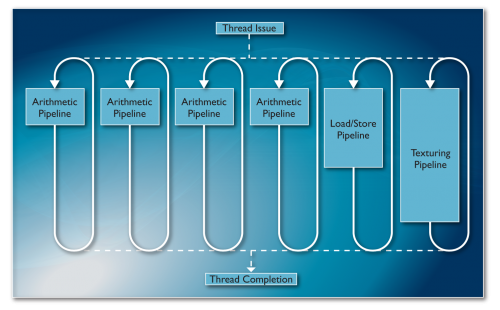Today, during the Japanese leg of the ARM Technical Symposia 2011, ARM unveiled its new up to eight-core Mali-T658 GPU, claiming hundreds of gigaflops of performance. Smartphones with the T658 GPU are expected to be available in two years, according to ARM.
ARM says the new design both doubles the number of cores and the arithmetic pipelines per core, resulting in up to 10x greater performance than the current Mali-400 MP, which is found in phones such as the Samsung Galaxy S II and currently is the most powerful GPU present on a mobile device, with the exception of some tablet devices.
This release seems like a reasonable one, as dies shrink and power consumption improves, manufacturers will want the option to add more cores and keep within the same power envelope. The increase in arithmetic power is ARM's first serious steps into GPGPU field, following on from its earlier announcement of the Mali-T604.
Floating-point calculations on the new design are fully-IEEE 754-2008 double-precision compliant, enabling the use of Full Profile OpenCL. Thanks to ARM's flexible 'tri-pipe' design, arithmetic, texture and load/store units remain separate, and this not only allows for flexible hardware that is able to support OpenGL ES, OpenVG, DirectX 11, OpenCL, Google RenderScript and Microsoft DirectCompute, but also enables highly effective power management as pipelines can be shutdown when not in use - for example when performing general-purpose calculations while being able to turn-off texture hardware in a bid to save power.

GPGPU technology has already penetrated other market areas and the mobile community has been looking for its arrival for several years now, with only partial solutions currently on offer. GPGPU makes a whole lot of sense in the mobile sector, elements such as image recognition, portable displays with Kinect-like feedback and voice recognition are becoming very popular.
Typically general processors are not efficient at handling this kind of data and processing it requires the full attention of the CPU as it attempts to calculate what are mostly mathematical floating-point calculations. GPUs, with their simplified logic but powerful arithmetic processing, are perfect for these scenarios, able to crunch numbers on a much greater scale in a similar power-envelope, whilst leaving the CPU free to handle serial-processing tasks
Both ARM and this writer are particularly looking forward to the use of Google RenderScript on this new GPU, as it enables general-purpose compute from Android. Exciting times!













